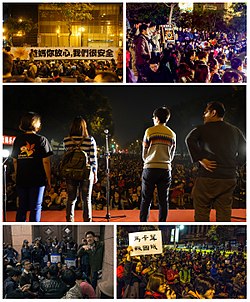Sunflower Student Movement
| Sunflower Student Movement | |||
|---|---|---|---|
 |
|||
| Date | March 18, 2014 – April 10, 2014 (23 days) | ||
| Location |
25°2′39.8832″N 121°31′10.02″E / 25.044412000°N 121.5194500°ECoordinates: 25°2′39.8832″N 121°31′10.02″E / 25.044412000°N 121.5194500°E |
||
| Causes | Cross-Strait Service Trade Agreement | ||
| Goals |
|
||
| Methods | sit-ins, Occupation (protest), strike actions, demonstrations, online activism, protest marches, civil disobedience, civil resistance, student activism | ||
| Result | Review of trade pact postponed | ||
| Parties to the civil conflict | |||
|
|||
| Lead figures | |||
|
|
|||
| Number | |||
|
|||
| Sunflower Student Movement | |||||||||||||||
| Traditional Chinese | 太陽花學運 | ||||||||||||||
|---|---|---|---|---|---|---|---|---|---|---|---|---|---|---|---|
| Simplified Chinese | 太阳花学运 | ||||||||||||||
| Literal meaning | Sunflower Student Movement | ||||||||||||||
|
|||||||||||||||
| Transcriptions | |
|---|---|
| Standard Mandarin | |
| Hanyu Pinyin | Tàiyáng Huā Xué Yùn |
| Wade–Giles | |
| Jyutping | |
| Southern Min | |
| Hokkien POJ | Thài-iông Hoe Ha̍k Ūn |
Students and civic groups
Legislative Yuan
The Sunflower Student Movement is associated with a protest movement driven by a coalition of students and civic groups that came to a head on March 18 and April 10, 2014, in the Legislative Yuan and, later, also the Executive Yuan of Taiwan. The activists protested the passing of the Cross-Strait Service Trade Agreement (CSSTA) by the ruling party Kuomintang (KMT) at the legislature without clause-by-clause review.
The Sunflower protesters perceived the trade pact with the People's Republic of China (China; PRC) would hurt Taiwan's economy and leave it vulnerable to political pressure from Beijing, while advocates of the treaty argued that increased Chinese investment would provide a necessary boost to Taiwan’s economy, that the still-unspecified details of the treaty’s implementation could be worked out favorably for Taiwan, and that to “pull out” of the treaty by not ratifying it would damage Taiwan’s international credibility. The protesters initially demanded the clause-by-clause review of the agreement be reinstated, later changing their demands toward the rejection of the trade pact, the passing of legislation allowing close monitoring of future agreements with China, and citizen conferences discussing constitutional amendment. While the Kuomintang was open to a line-by-line review at a second reading of the agreement, the party rejected the possibility that the pact be returned for a committee review. The KMT backed down later, saying that a joint review committee could be formed if the Democratic Progressive Party (DPP) did not boycott the proceedings. This offer was rejected by the DPP. The party asked for a review committee on all accords with China, citing "mainstream public opinion." In turn, the DPP proposal was turned down by the KMT.
The movement marked the first time that the legislature has been occupied by citizens in the history of the Republic of China (ROC), which has governed Taiwan since retrocession in 1945.
...
Wikipedia
